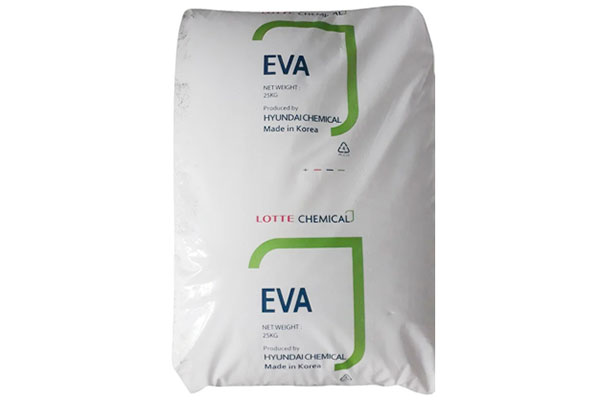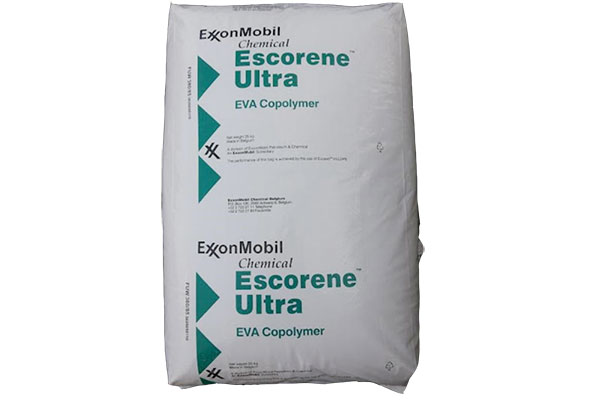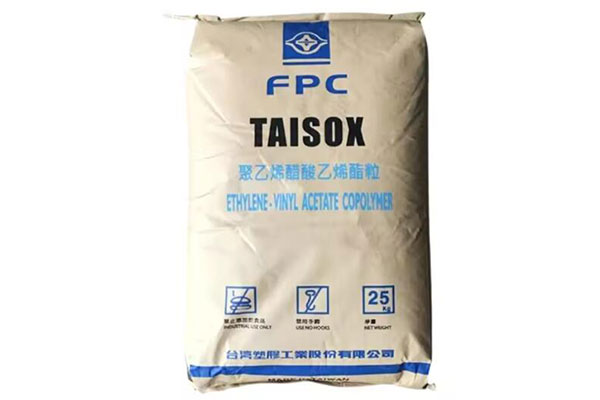Home » EVA Copolymer
EVA Copolymer for Sale in Our Company
EVA copolymer (Ethylene Vinyl Acetate) is a thermoplastic elastomer derived from the polymerization of ethylene and vinyl acetate. It is a versatile thermoplastic material widely used in industries ranging from footwear to solar energy. Known for its flexibility, durability, and chemical resistance, Ethylene Vinyl Acetate copolymer has become a preferred choice for manufacturers seeking cost-effective and high-performance polymer solutions.
The ratio of vinyl acetate (VA) content (typically 5%-40%) determines its flexibility and applications.
Low VA content (5%-10%): Rigid, used in films and cables.
Medium VA content (10%-20%): Flexible, ideal for footwear.
High VA content (20%-40%): Rubber-like, used in adhesives and foams.
| Models | Trademark | VA Content |
| LVS430 | LOTTE | 18% |
| VS410 | LOTTE | 26% |
| VS420 | LOTTE | 21.5% |
| VS430 | LOTTE | 19% |
| VS440 | LOTTE | 15% |
| VA600 | LOTTE | 28% |
| VA800 | LOTTE | 28% |
| VA810 | LOTTE | 33% |
| VA900 | LOTTE | 28% |
| VA910 | LOTTE | 28% |
| VA920 | LOTTE | 19% |
| VA930 | LOTTE | 19% |
| VC590 | LOTTE | 28% |
| VC640 | LOTTE | 15% |
| VC710 | LOTTE | 33% |
| VE800 | LOTTE | 26% |
| VL730 | LOTTE | 18% |
| VL830 | LOTTE | 18% |
| 3120 | ELVAX™ | 7.5% |
| 3150 | ELVAX™ | 15% |
| 460A | ELVAX™ | 18% |
| 40W | ELVAX™ | 18% |
| 220W | ELVAX™ | 28% |
| 210W | ELVAX™ | 28% |
| 150W | ELVAX™ | 32% |
| FL 00018 | Escorene™ | 17.5% |
| FL 00019 | Escorene™ | 19% |
| FL 00014 | Escorene™ | 14% |
| FL 00212 | Escorene™ | 12% |
| FL 00328 | Escorene™ | 27% |
| UL 00018 | Escorene™ | 17.5% |
| UL 7510 | Escorene™ | 18.7% |
| 7350M | TAISOX® | 18% |
| 7470M | TAISOX® | 26% |
| 7470K | TAISOX® | 26% |
| 7760H | TAISOX® | 28% |
Would Like The Quotation
Leave more about your requirements, such as, brands, models, quantity, package, country, etc.
Key Properties of Ethylene Vinyl Acetate Copolymer
Flexibility and Elasticity.
EVA copolymer is highly elastic, making it perfect for shoe midsoles (running shoes, sandals), foam padding (yoga mats, sports equipment).
Weather and Chemical Resistance
UV-resistant: Used in solar panel encapsulation.
Waterproof: Ideal for marine applications.
Resistant to oils & acids: Suitable for industrial gaskets.
Thermal Stability and Low-Temperature Performance
Remains flexible at -70°C to 60°C (used in cold-weather gear).
Excellent heat-sealing properties (packaging films).
Industrial Applications of EVA Polymer
1. Foam Manufacturing: Lightweight and Versatile Solutions
EVA polymer is a preferred material for foam production due to its exceptional cushioning, shock absorption, and moldability.
Key applications include:
Protective Packaging
EVA foam sheets are widely used for custom inserts in electronics, medical devices, and fragile goods, providing superior impact resistance compared to traditional materials like polystyrene.
Sports & Leisure
From yoga mats to gym flooring, EVA’s non-slip and fatigue-resistant properties enhance safety and comfort. It’s also a staple in helmets, knee pads, and sports equipment for its lightweight durability.
Automotive Interiors
EVA foam is utilized in car headliners, dashboards, and armrests, offering noise reduction and thermal insulation.
2. Solar Energyfield: Ensuring Durability in Photovoltaics
In the solar panel industry, EVA copolymer serves as a critical encapsulant for photovoltaic cells. Its unique properties address key challenges:
UV Resistance: Protects solar cells from long-term sun exposure degradation.
Moisture Barrier: Prevents water ingress, reducing microcracks and efficiency loss.
Optical Clarity: Maintains high light transmittance to maximize energy conversion.
3. Footwear & Textiles: Combining Comfort and Performance
EVA copolymer revolutionized the footwear industry by replacing heavier rubber and PVC in midsoles.
Its advantages include:
Lightweight Cushioning: Many Brands use EVA in running shoes and sandals for energy return and comfort.
Customizable Density: Adjusting VA content allows manufacturers to tailor hardness for athletic shoes, orthotics, or fashion footwear.
Hot Melt Adhesives: EVA-based adhesives bond fabrics, soles, and synthetic materials in shoe assembly, offering strong yet flexible seams.
4. Adhesives & Sealants: High-Performance Bonding
With high VA content (20-40%), EVA copolymer becomes an excellent base for hot melt adhesives, used in:
Woodworking: Furniture assembly and veneer bonding.
Packaging: Carton sealing and label adhesion.
Textiles: Non-woven fabric lamination (e.g., disposable medical gowns).
5. Emerging Applications: Innovation Driven by Sustainability
Biodegradable Foams: Modified EVA blends that decompose faster than conventional plastics.
Electric Vehicle (EV) Components: Battery insulation and lightweight interior panels.
Would Like The Quotation
Leave more about your requirements, such as, brands, models, quantity, package, country, etc.
Classification of EVA Copolymer Based on VA content and Different Applications
1. Low VA content (5%-15%)
Properties:
High crystallinity, close to the performance of polyethylene (PE).
Good rigidity, wear resistance and chemical stability.
Low flexibility and transparency.
Main uses:
Films: agricultural greenhouse film, packaging film need puncture resistance.
Injection molded products: soles, toys, hard parts in daily necessities.
Wires and cables: insulation layer protection materials.
Modified substrate: blended with PE to improve toughness.
2. Medium VA content (15%-30%)
Properties:
Balanced flexibility and strength.
Excellent impact resistance and elasticity.
Good transparency and bonding properties.
Main uses:
Shoe materials: sports shoe midsoles (foamed EVA can provide good shock absorption).
Adhesives: hot melt adhesive, pressure-sensitive adhesive (bonding to paper and wood).
Photovoltaic encapsulation: solar cell film requires high weather resistance and light transmittance.
Medical supplies: medical catheters, packaging materials need to be non-toxic and flexible.
3. High VA content (30%-40%)
Properties:
Low crystallinity, rubber-like elasticity.
High transparency, softness and low temperature performance.
Strong adhesion and stress cracking resistance.
Main uses:
High-end adhesives: high-viscosity hot melt adhesives for labels and packaging.
Soft films: disposable gloves, medical dressings.
Automotive parts: sealing strips, sound insulation materials need to be resistant to low temperatures.
4. Ultra-high VA content (40%-50% and above)
Properties:
Completely amorphous, close to elastomer performance.
Excellent flexibility, adhesion and low temperature resistance.
Low mechanical strength, easy to process and modify.
Main uses:
Special adhesives: high-performance industrial adhesives, such as automotive interior bonding.
Coating materials: waterproof coatings, fabric coatings which require high conformability.
Elastomer modification: blending with rubber to improve performance.
Key Factors in VA content Selection
Flexibility requirements. The higher the VA content, the softer the material.
Adhesive properties. High VA content improves viscosity and is suitable for adhesives.
Processing conditions. Low VA is easier to injection mold, and high VA is suitable for extrusion or coating.
Cost considerations. Increased VA content usually increases raw material costs.
By adjusting the VA content, ethylene vinyl acetate eva can meet a variety of needs from rigid packaging to flexible adhesives. In practical applications, performance is often further optimized through blending or additives.
Would Like The Quotation
Leave more about your requirements, such as, brands, models, quantity, package, country, etc.
How to Process Ethylene Vinyl Acetate Polymer?
Ethylene Vinyl Acetate polymer is a highly versatile thermoplastic that can be processed using various methods, depending on the desired end product.
1. Injection Molding
The process method is suitable for the production of shoe soles, toys, automotive parts, and industrial components.
Steps:
Pre-drying (if necessary) at 50-60℃ to remove moisture.
The material is fed into a heated barrel (150-200℃) and melted.
A screw mechanism injects the molten EVA into a mold cavity.
The mold is cooled (water or air) to solidify the part.
Final product is ejected, trimmed, and inspected.
2. Extrusion
The process method is suitable for the production of EVA sheets, films, tubing, and profiles.
Steps:
EVA pellets are fed into an extruder barrel with rotating screws.
Heated zones (120-200℃) melt the polymer uniformly.
The molten EVA is forced through a die (flat for sheets, circular for tubes).
The extruded material passes through cooling rollers or water baths to solidify.
Finally, cut into sheets, rolls, or coiled for further processing.
3. Thermoforming
The process method is best for packaging trays, automotive liners, and medical device casings.
Steps:
Pre-made EVA foam or rigid sheets are loaded into the machine.
Foam or sheets are heated to softening temperature (90-160℃).
Vacuum or pressure molds the sheet into the desired shape.
4. Compression Molding
The process method is best for high-volume EVA foam products (shoe midsoles, yoga mats).
Steps:
EVA pellets or pre-cut sheets are placed in a mold cavity.
The mold is closed and heated (160-200℃) under high pressure.
Chemical foaming agents (if used) expand the material.
The mold is cooled, and the foamed product is removed.
5. Blow Molding
The process method is suitable for hollow EVA products (bottles, containers).
Steps:
Molten EVA is extruded into a hollow tube or parison.
Parison is clamped between molds and inflated with compressed air.
The part cools, and excess material is trimmed.
6. Calendering
The process method is best for thin EVA films (Like: solar panel encapsulants, adhesive backings).
Steps:
EVA pellets are melted and mixed in an internal mixer.
The molten EVA passes through a series of heated rollers to achieve uniform thickness.
The film is cooled and wound into rolls.
Ethylene Vinyl Acetate Price Trend
Recent price monitoring data shows that the price of photovoltaic-grade EVA (VA content 28%-33%) is about 15%-20% higher than that of shoe-grade EVA (VA content 10%-15%). It is mainly due to the rapid growth of the global photovoltaic industry, which has driven the demand for high-end EVA products. The price of foaming-grade EVA is relatively stable, but it is greatly affected by the fluctuation of raw material prices.
Key Factors Affecting EVA Prices
1.Fluctuation of raw material costs
The main raw materials for EVA production are ethylene and vinyl acetate monomer (VAM), which together account for about 70%-80% of the production cost. Ethylene prices are highly correlated with international crude oil prices, while VAM prices are affected by the supply of acetic acid and ethylene. Since 2022, the global energy crisis has caused ethylene prices to fluctuate significantly, which has directly affected the production cost of EVA copolymer.
2. Changes in supply and demand
From the supply side, global EVA production capacity is mainly concentrated in East Asia, North America and Western Europe. In terms of demand, the explosive growth of the photovoltaic industry has become the main driving force for EVA demand. It is expected that by 2025, the photovoltaic field will account for more than 40% of global EVA consumption.
3. Competition of substitutes
Polyolefin elastomer (POE), as a potential substitute for EVA, competes with EVA in the field of photovoltaic packaging. POE has better weather resistance and anti-PID performance, but the price is usually 20%-30% higher than EVA. Changes in the price difference between the two polymers will affect the material selection of downstream manufacturers.
- Email: sales@chemategroup.com
- Tel: 0086-371-60921621
- Whatsapp: +86 18624832876
- Wechat: +86 18624832876
- ADD: NO.80 PUHUI ROAD,ZHENGZHOU CITY, HENAN PROVINCE, CHINA



